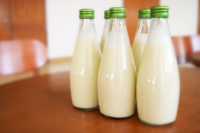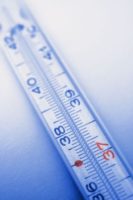Chain Reaction: Data Solutions for Cold Chain Temperature Monitoring

Consumers today expect a wide variety of safe and fresh food to be available, regardless of season. However, as consumer demand and food supply chains become more complex, it’s increasingly difficult to maintain safety and quality from farm to fork. For this reason, temperature monitoring has emerged as a necessary solution for keeping track of food during transportation, storage and display.
Food Safety and Quality Risks
According to the U.S. Centers for Disease Control and Prevention, one in six Americans gets sick by consuming contaminated food or beverages each year. [1] In fact, there are more than 250 foodborne illnesses, including Escherichia coli, Norovirus and Salmonella that can cause unpleasant symptoms, hospitalization, disability and even death. Foodborne illnesses negatively impact food retailers and restaurants because they lead to negative reviews, lost business, employee turnover, health code violations and fines. Repeated incidents can even lead to extended or permanent business closures, so it’s always important to maintain food safety.
Food quality, or the look, taste, smell and feel of food, is also critical. Quality can differentiate products, stores and restaurants from competitors, command higher prices and keep customers satisfied and returning. However, if food quality is not preserved during transport and storage, products arrive on shelves in a stressed condition and don't last as long as they should. Then, products are either thrown out, or worse; leave the customer with a negative experience. Improving quality allows organizations to reduce waste, increase revenues and keep customers happy.
Cold Chain Solutions
Temperature plays a key role in upholding food safety and quality throughout the transportation and storage process. Food must travel from the producer to the distribution center. Then it makes its way to grocery stores, convenience stores and restaurants, or to the customer’s home. At any point, temperatures that are too cold or too hot can compromise food safety and quality.
Although there is legislation in place to encourage better food protection, such as the Food and Drug Administration’s Food Safety Modernization Act, the adoption of effective solutions is key to shifting the focus from responding to food contamination to preventing it. One way to prevent food safety and quality issues is by monitoring the cold chain to pinpoint areas where temperature performance is creating unsafe conditions. Today, economical, reliable and reusable solutions integrate and analyze data to provide greater visibility from farm to fork. These solutions will ensure continuing food safety and quality within distribution centers and during transportation, thus reducing food contamination, waste and customer dissatisfaction.
Temperature monitoring solutions work by pairing data logging “tags” with each company and product being shipped and stored. These tags are started with the push of a button and leverage radio-frequency identification so that they can be read wirelessly. Data is gathered at each decision point and sent to the cloud automatically so that results can be viewed online. Time and temperature data are coupled with other relevant data—delivery records, carriers, GPS locations and weather—to add even more value to the information.
The Impact of Temperature Monitoring
Electronic data capture and cloud-based reporting makes it easy for organizations to track the state of food. By utilizing algorithms for timely and automated decision-making, organizations can easily complete a wide range of tasks, including:
• Accept or reject shipments
• Determine remaining product shelf-life for in-store pricing and promotions
• Identify issues with products
• Improve performance, accountability and transparency with all parties across the cold-chain
Keeping food at the correct temperature during storage and transport is a critical part of bringing safe, high-quality food to consumers. Although we live in a time of increasingly complex consumer demands for safe, tasty, fresh and varied foods, we are fortunate to have impressive technological advances and innovations available globally. Temperature monitoring systems that track and analyze results will be instrumental in maintaining higher quality food supply chains and reducing the incidence of illnesses and lost revenue.
Cameron Adams is global director of strategic planning and development with Diversey Care, a provider of commercial cleaning, sanitation and hygiene solutions. Learn more about Sealed Air’s TempTRIP monitoring system by visiting us online.
References
1. http://www.cdc.gov/foodsafety/facts.html#what.
Looking for a reprint of this article?
From high-res PDFs to custom plaques, order your copy today!




